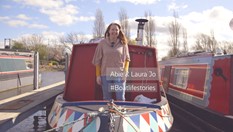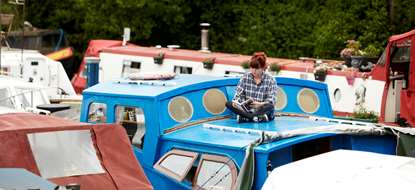Choosing the right boat can be overwhelming, especially if you’re new to the boating world. With so many options and different types of boats on the market, knowing where to start and what to look for can be a challenge.
So, if you’re unsure what boat type is best, this guide is for you. Here, we’ll show you the best boat types to consider, with an explanation of their ideal use cases. On this boat buying guide, you’ll learn:
- 6 Types of boats to buy
- What type of boat to buy
- How to choose the right boat
Let’s get into it...
Choosing the right boat: Types of boats to buy
1. Narrowboats
Narrowboats are narrow canal boats perfect for exploring England and Wales's waterways.
They are relatively inexpensive to buy and run and can be used to travel the UK’s extensive canal system.
Full-time boaters often select narrowboats to use as a permanent liveaboard to continuously cruise the canals or remain in one place at a residential mooring.
2. Wide Beams
As the name suggests, Wide Beams are substantially wider than narrowboats, offering more space for living and sleeping.
The extra width makes them suitable for use as a liveaboard and to cruise the river system.
Due to their size, they may be more expensive to buy and run than a narrowboat.
3. Dutch Barges
Originally a type of commercial fishing vessel in the Netherlands, Dutch Barges are large, traditional boats perfect for European river cruising and journeys along the coast.
They are very comfortable and spacious, which has made Dutch Barges a popular choice for houseboat conversions.
With width sizes of up to 20 feet, they can be hard to handle for beginners and may not be suited to narrow UK canals.
Learn more about this popular boat by checking out our in-depth guide to the pros and cons of Dutch Barges.
4. Coastal Cruisers
As the name might suggest, Coastal Cruisers are at home peacefully cruising along Britain’s stunning coast.
They’re typically larger than narrowboats and wide beams with more space for living and sleeping, making them a great choice for family vacations or to live on full-time.
5. Inland Cruisers
On the flip side, Inland Cruisers are at home cruising on rivers and lakes and are typically smaller than coastal cruisers.
They offer less space for living and sleeping but are usually cheaper to buy than other boat options, and running costs are relatively low.
6. Yachts
For those who want to sail the open ocean, yachts are the ideal vessel. These boats are the largest and most expensive type of boat on the market.
They are available in various sizes designed for long-distance cruising, and higher-end models can offer refined luxury and spacious accommodations.
How to choose the right boat
When choosing the right boat, there are a few things you need to consider to ensure that the vessel you choose is suited to the type of boating or sailing it will be used for. You need to ask questions and consider where the boat will be used and how many people will typically be aboard.
Consider your level of boating experience and factor in your budget. Beginner boaters may be better suited to vessels like narrowboats as they are easy to learn and operate. These types of boats are less expensive than some of the larger luxury boats.
Experienced boats can consider vessels like Dutch Barges, which offer plenty of space but are sometimes harder to control.
But if you want to go high-end, consider buying a yacht. Yachts come in various lengths and are known for offering the ultimate levels of luxury and comfort - perfect for long-distance cruising and extended trips.
Questions to ask yourself
Searching for a boat can be made easier by asking the right questions. These will help you to determine the right size and style of boat.
- What are the primary uses for the boat? (Occasional sailing, continuous cruising?)
- How many people will I need to accommodate on board?
- How much space do I need for storage and equipment?
- What budget do I have available?
- Will I be boating in a hot or rainy climate?
- Who will handle the maintenance?
- How will I cover the cost of repairs?
Other boat styles
While our list of boat types shows some of the best available, many others are worth considering. Whether you’re looking at fishing or want to reach high speed on the open sea, there’s a perfect boat for every use case.
Fishing boats - come in different sizes and styles and are powered by petrol or diesel engines. They may be used for offshore or inshore fishing both recreationally and commercially.
Sailboats - are powered by the wind and used for competitive racing, recreational cruising, or simply to enjoy being on the water.
Powerboats - are propelled across the water by a high-powered engine. This style of boat is designed for high performance and is used for high-speed racing competitions or fast and exhilarating trips across the water.
RIBs (Rigid Inflatable Boats) - are inflatable boats or dinghies styled with a rigid hull. They are often used for fishing, diving, and other water sports. They are designed for short trips and are usually open and uncovered, making them unsuitable for extended use.
Tenders - are small boats used to transport people and equipment to and from larger boats or from a larger boat to the shore. They are often used by yachts, cruise ships, and other large vessels.
Finding a boat best suited to your needs is crucial, especially when considering financial investment and ongoing maintenance.
If you are new to boating or are still trying to figure out where to start, a professional boat dealer like Aquavista can help you choose the right vessel.
Check out our boats for sale or contact us to learn more about the perfect boat type for you.




